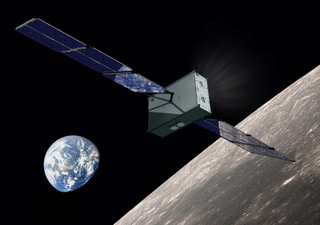NASA is working with university teams to develop tiny tech for space trips

While NASA has big plans to return humans to the moon in 2024 under its Artemis program, the agency is also thinking small by working to support the development of tiny robots and satellites.
NASA announced that it will collaborate with nine university teams to develop satellite technologies related to navigation, propulsion and the management of heat transfer in small machines. The agency did not specify the launch dates for the satellites, and not all of them will necessarily go to space. But the overall goal is to "help blaze the trail" for future crewed missions, NASA officials said in a statement.
"As we prepare for the next robotic and crewed missions to the Moon, we expect small spacecraft to help forge the path ahead by scouting terrain, prospecting for resources and establishing communications and navigation capabilities," Christopher Baker, program executive for the Small Spacecraft Technology Program, added in the statement. "Taking advantage of their small size and shorter development timelines, small spacecraft are increasingly capable as both rapid precursor missions and as cost-effective, in-space infrastructure."
Related: NASA's 'critical path' to the moon no longer requires a Lunar Gateway
The goal of the program is to mature nascent technologies for moon exploration, NASA said, especially to help astronauts on future crewed missions to the moon accomplish more than the Apollo crews were able to do with their available technologies in the 1960s and 1970s. NASA's longer-term goals are to build a "sustainable presence" on the moon and to test technologies there for an eventual Mars mission in the mid-2030s.
The program includes the following missions:
- "Deployable Optical Receiver Aperture for Lunar Communications and Navigation" is a device designed to make communications easier and simpler (Arizona State University, in collaboration with NASA's Jet Propulsion Laboratory in California).
- "Flat Panel Phased Array Antennas with Two Simultaneous Steerable Beams Utilizing 5G Ka-Band Silicon RFICs for Tx/Rx Communications Between 6U Small Satellite and Lunar Surface, Gateway and Earth" will work to form a high-performance data communications network (San Diego State University in collaboration with NASA's Glenn Research Center in Cleveland).
- "High-precision Continuous-time PNT Compact Module for the LunaNet Small Spacecraft" will create a GPS-like system for the moon (University of California, Los Angeles, in collaboration with JPL).
- "A Small Satellite Lunar Communications and Navigation System" will use a communications protocol similar to what cellphones use on Earth (University of Colorado, Boulder, in collaboration with JPL).
- "On-Orbit Demonstration of Surface Feature-Based Navigation and Timing" will test terrain navigation using lunar craters (University of Texas at Austin, in collaboration with NASA's Johnson Space Center in Houston).
- "Variable Specific Impulse Electrospray Thrusters for SmallSat Propulsion" will use electrostatic charges and liquid droplets to generate thrust (University of California, Irvine, and California Polytechnic State University, in collaboration with JPL).
- "Lunar Missions Enabled by Chemical-Electrospray Propulsion" will aim to test a propulsion system that can work using combustion or electrospray/ion propulsion (University of Illinois, Urbana-Champaign, in partnership with Froberg Aerospace LLC and Glenn and NASA's Goddard Space Flight Center in Maryland).
- "3D Printed Hybrid Propulsion Solutions for SmallSat Lunar Landing and Sample Return" will test a 3D-printed hybrid rocket motor (Utah State University, in collaboration with NASA's Marshall Space Flight Center in Alabama).
- "An Additively Manufactured Deployable Radiator with Oscillating Heat Pipes to Enable High-Power Lunar CubeSats" will use a 3D-printed deployable radiator that should transfer heat more efficiently than traditional technology (California State University and California Polytechnic State University, in collaboration with JPL).
- Orbital ATK Unveils New Version of Satellite-Servicing Vehicle
- Orbit Fab Demonstrates Satellite Refueling Technology on Space Station
- Satellite Quiz: How Well Do You Know What's Orbiting Earth?
Follow Elizabeth Howell on Twitter @howellspace. Follow us on Twitter @Spacedotcom and on Facebook.
Get the Space.com Newsletter
Breaking space news, the latest updates on rocket launches, skywatching events and more!
OFFER: Save at least 56% with our latest magazine deal!
All About Space magazine takes you on an awe-inspiring journey through our solar system and beyond, from the amazing technology and spacecraft that enables humanity to venture into orbit, to the complexities of space science.
Join our Space Forums to keep talking space on the latest missions, night sky and more! And if you have a news tip, correction or comment, let us know at: community@space.com.

Elizabeth Howell (she/her), Ph.D., is a staff writer in the spaceflight channel since 2022 covering diversity, education and gaming as well. She was contributing writer for Space.com for 10 years before joining full-time. Elizabeth's reporting includes multiple exclusives with the White House and Office of the Vice-President of the United States, an exclusive conversation with aspiring space tourist (and NSYNC bassist) Lance Bass, speaking several times with the International Space Station, witnessing five human spaceflight launches on two continents, flying parabolic, working inside a spacesuit, and participating in a simulated Mars mission. Her latest book, "Why Am I Taller?", is co-written with astronaut Dave Williams. Elizabeth holds a Ph.D. and M.Sc. in Space Studies from the University of North Dakota, a Bachelor of Journalism from Canada's Carleton University and a Bachelor of History from Canada's Athabasca University. Elizabeth is also a post-secondary instructor in communications and science at several institutions since 2015; her experience includes developing and teaching an astronomy course at Canada's Algonquin College (with Indigenous content as well) to more than 1,000 students since 2020. Elizabeth first got interested in space after watching the movie Apollo 13 in 1996, and still wants to be an astronaut someday. Mastodon: https://qoto.org/@howellspace
